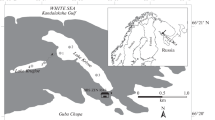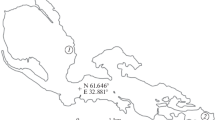Summary
The stunted growth of the Dutch perch was studied. To calculate the age and former growth the winterrings of the scales were used. The excellent growth of perch in some parts of Holland in contrast to the bad growth reported by foreign authors is discussed. It is pointed out that the latter growth may be ascribed to the existence of false winterrings, from which one can get rid by dipping the scales in a HCl-solution.
It appeared that the initial growth of the stunted perch up to about 13 cm is good. The stunted growth afterwards must be ascribed to a shortage of prey-fish. Especially the smelt seems to be very important. As, however, in Holland young roach are abundant it seems incomprehensible why these cannot serve for suitable perch-food. To investigate this problem the conduct of hunting perch was studied in an aquarium.
The results of the aquarium-experiments were in agreement with the change in food-diet at a certain length discussed by other authors; also with the assumption that middle-sized perch do not prey upon smaller congeners.
Concerning the preying upon roach it became clear that a single perch will scarcely or not succeed in seizing a roach. The hunting is accomplished by cooperation in open water stretches. Amidst plants perch does not hunt. Hence the stunted growth of perch in Holland must be ascribed to the many plants in Dutch waters, between which the roach may easily escape hunting by perch.
A short comparison of prey-sizing by wels, pike pike-perch and perch is made.
Similar content being viewed by others
References
Alm, G., 1946. Reasons for the Occurrence of stunted Fish-Populations. Rep. Swedish State Inst. Freshwater Fish. Res., Drottningholm, no 25.
Brouwer, A. B. Verslag over de Visserij gedurende het Jaar 1930. Verslagen en Mededelingen van de Afdeling Visserij en vat het Departement van Binnenlandse Zaken en Landbouw, no 17, The Hague, 1931.
Geyer, F. and H. Mann, 1939. Limnologische und fischereibiologische Untersuchungen am Ungarischen Teil des Fertö. Arb. des Ungar. Forsch. inst. 11: 64–193.
Havinga, B., 1945. Rapport betreffende de Visscherij en den Vischstand op het IJsselmeer. Unpublished.
Hartley, P. H. T. The coarse Fishes of Britain. 12th Sci. Publ. Freshwater Biol. Brit. Empire. Ambleside, Westmorland, 1947.
Hartley, P. H. T. 1947-'48. The natural History of some British freshwater fishes. Proc. Zool. Soc. Lond. 117: 129–206.
Leskien, J., 1942. Beitrag zur Biologie des Stintes (Osmerus eperlanus L.). Z. Fischerei 40: 49–102.
Marre, G., 1931. Fischereiwissenschaftliche Untersuchungen über die Grundlage der Stintfischerei im Kurischen Haff. Z. Fischerei 29: 443–512.
Mohr, E., 1924. Beiträge zur Naturgeschichte des Barsches und des Kaulbarsches. Mitteil. Zool. Staatinst. u. Zool. Mus. Hamburg 40: 79–94.
— Stint (Osmerus Artedi) Handbuch der Binnenfischerei III, Lf. 7, Stuttgart, 1941.
Neahaus, E., 1934. Studien über das Stettiner Haff und seine Nebengewässer III. Untersuchungen über den Zander. Z. Fischerei 32: 599–634.
Neuhaus, E., 1936. Studien über das Stettiner Haff und seine Nebengewässer IV. Untersuchungen über die Plötze. Z. Fischerei 34: 63–111.
Nikolsky, G., 1945. The principal problems of the modern ichthyology. Bull. Soc. Nat. Moscou, Sect. Biol. 50, (5–6): 12–13.
Nümann, W., 1939. Untersuchungen über die Biologie einiger Bodenseefische in der Uferregion und den Randgebieten des freien Sees. Z. Fischerei 37: 637–688.
Ottestad, P., 1938. On the Relation between the Growth of the Fish and the Growth of the Scales. Rapp. et Proc. Verb. 108: 23–31.
Redeke, H. C., 1921. Voorlopig Verslag over Onderzoekingen betreffende de slechte Groei van Baars in den Geestmerambachtpolder. Verslagen Inst. Biol. Visserij-onderzoek, 1920: 10–18.
—1925. Rapport aan den Minister van Binnenlandsche Zaken en Landbouw betreffende de maat op baars. Unpublished.
Röper, K. C., 1936. Ernährung und Wachstum des Barsches (Perca fluviatilis L.) in Gewässern Mecklenburgs und der Mark Brandenburg. Z. Fischerei 34: 567–638.
Segerstråle, C., 1933. Über scalimetrische Methoden zur Bestimmung des linearen Wachstums bei Fischen. Acta Zoologica Fennica 15.
Svetovidov, A., 1929. To the Question of Age and Growth of Perch, Rudd and Pike from the Lake Krugloe. Rev. Zool. Russe 9, (4): 21–22.
Willer, A., 1926. Untersuchungen über den Stint (Osmerus eperlanus L.) in Ostpreussen. Z. Fischerei 24: 521–558.
Author information
Authors and Affiliations
Rights and permissions
About this article
Cite this article
Deelder, C.L. A contribution to the knowledge of the stunted growth of perch (Perca fluviatilis L.) in Holland. Hydrobiologia 3, 357–378 (1951). https://doi.org/10.1007/BF00045560
Issue Date:
DOI: https://doi.org/10.1007/BF00045560




